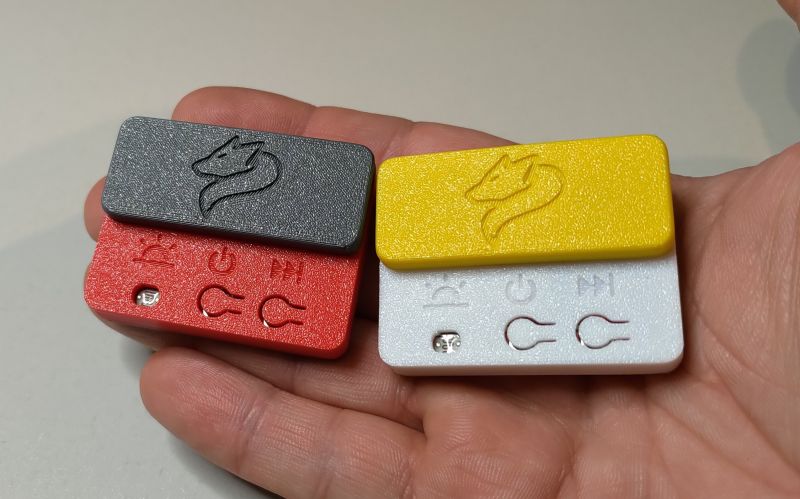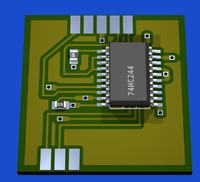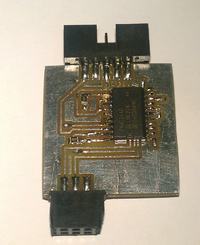Update No. 3 Soft v.1.3 o Fixed bug when uploading HEX files that do not start with address 0 - e.g. bootloaders.
o the size of the hex file is a bit faster
o modified "config.ini" file - now it will be more readable
o added OSCCAL setting to "config.ini" file - if you use increased programmer speed (bit0 in "config.ini" file) then you can enter your own calibration from 00 to FF - some procks failed at maximum overclocking.
o added the MAX SCK setting to the "config.ini" file - if for some reason the programmer incorrectly selects the SCK speed (too fast) and there are errors, you can select the maximum speed from which the programmer will start.
o added file deletion function - select the file and while holding the LE button press the RI button. Release the LE button to exit.
o resistance to vibration of button contacts has been improved
o fixed support for chips with extended memory (atmega2560 and atmega2561)
o added the "manual" function that allows you to enter your own fusebits. Scroll through each character with UP and DN buttons, use RI button to confirm your selection and go to the next character. After confirming the last one, the programmer will save and then read the fuses and display them in the bottom line. You can cancel with the LE button. The program takes FACTORY DEFENSES for a given layout, and this is what we edit.
Be careful when using options! I posted a short video
HERE option can be said in beta.
o added an additional lowest SCK speed - 8kHz - it is possible to program chips clocked with clockwork quartz.
o the way of naming created files has been changed. From now on, the names will have the form "m8-xx", "m162-xx", "t2313-xx" where x is the sequence number. This makes it very easy to identify the files. It was enough to add ONE line of code and what a convenience
 o
o the chip.db file should be updated - I changed the prock names in it so that they do not contain slashes. If the program creates a name
file from the name of the prock, then the name "Atmega644 / A" will give rise to the name "m644 / -1" - the file with a slash cannot be read on
computer. I have replaced the slashes with dashes.
o a file with the "LICENSE.TXT" license has been added, it should be copied to the main directory of the card. It should be read and possibly his
Polish version of. The programmer will not work if this file is missing or if it has been modified.
o maybe there are still some changes, but I don't remember how to add anything :)
File changes: -config.ini
-chip.db 1.03
-new folders "welcome" and "goodbye".
- LICENSE.TXT file for version 1.3
Further suggestions: - memory auto program - both read and write, easy copying of whole processors, etc. I didn't enter it this time due to insufficient free memory. Please read the post above from my colleague
piotrva and submit any ideas

-detection of enabled lockbits before trying to read to the file - then we will get the appropriate information instead of creating an empty file
-safe change of daffodils - if after saving dregs the verification returns an error, the program will not release the reset but will allow you to re-write them. Then we will not block Prock due to communication errors - in fact it has not happened yet, but it's better to be safe than sorry

- xmega and PDI support - I will definitely try to add it

- "correct" handling of HEX files in this version I have not introduced, because the topic is a bit deeper. It is not only about the correct adding of extended addressing, but most of all about the possibility of random programming of memory fragments. While programming bytes is a piece of cake, when programming by pages, the program must be smart enough not to get lost.
FAQ - or frequently asked questions and answers I will supplement this list over time, so far there are so many:
Q: I can't see anything on the screen / can't turn it on.
AT 1: Measure the voltage across the memory card capacitor and the display capacitor - they must be the same as the supply voltage.
O2: Make sure the display is in the correct alignment that all contacts connect in the right places.
O3: Look for assembly errors, make sure that the processor is correctly programmed.
AT 4: Make sure you have uploaded all files to the card.
AT 5: Make sure that the supply voltage is lower than 3.7V - otherwise the programmer will not turn on.
Q: The screen shows chaff, the subtitles are cut off. I can see a greeting.
ABOUT: Change the display type in the "config.ini" file - bit 7
Q: "ERROR" is displayed for a moment - no greeting. Subtitles may be shifted.
AT 1: The memory card has not been initialized. Make sure you format it to FAT16 or FAT32 and that it is a regular SD card up to 2gb (not SDHC).
O2: The capacitor on the memory card power supply should be at least 10uF, if the card does not work, increase the capacity to 22uF or even 33uF.
O3: Make sure that the power supply to the system is 3.3V (minimum 3.0V) - some cards need this voltage to start.
AT 4: Try a different card.
Q: Card has errors, files cannot be deleted or read.
ABOUT: Format the card and upload the files again.
Q: The card is no longer recognized by the computer.
ABOUT: Format the card in your phone or digital camera.
Q: The programmer selects a speed that is too high and verification reveals write errors.
AT 1: In the case of a long programming tape, change the max SCK frequency setting in the file "config.ini"
O2: If the tape is short, it means that the programmer works too fast (e.g. at 16.1MHz) and for the target chip clocked with e.g. 8MHz, the SCK speed will actually be 2.025MHz (and the maximum is 4 times smaller, i.e. 2.00MHz) - the whole works on error boundary. Reduce the calibration value "OSCCAL" in the file "config.ini" by a few units and check the behavior of the programmer.
O3: If the target system's ISP lines are loaded with something, use a buffer on these lines or reduce the speed manually in "config.ini"
Oh, today I have assembled 4 pieces of these programmers, each with a different memory card, with a 22uF capacitor for the card, with three different types of displays - all 4 started very nicely "from the kick" without any problems

All I had to do was choose the contrast for everyone.
In the attachment (hopefully) all the files: Before uploading a flash, please read the THIS LINK







